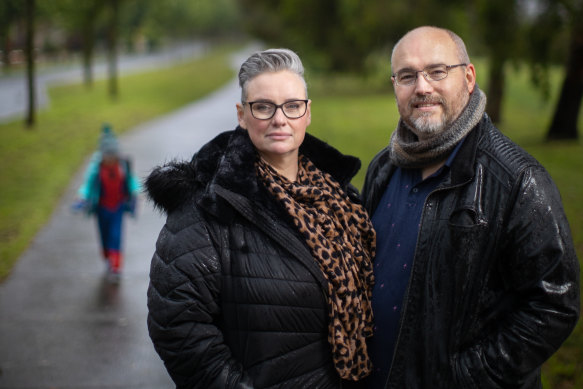Foster carers leaving system as cost of living, low allowance bites
Save articles for later
Add articles to your saved list and come back to them any time.
Victorian foster carers receive the lowest base payment of any state in Australia, with the sector losing nearly twice as many carers as it recruits.
Families looking after the state’s vulnerable children warn that the rising cost of living is forcing them to reconsider whether they can take them on and calling for an increase to the allowance.
Michael te Wierik and partner Fiona have cared for more than 70 foster children.Credit: Simon Schluter
Data collected by the Australian Institute of Health and Welfare shows that 621 households exited the foster care system in 2020-21, while 317 were recruited.
Foster Carer Association of Victoria (FCAV) figures collected in March 2023 show there was a 26 per cent drop in people going through the accreditation process. When combined with people leaving the system, this meant there were 100 fewer households available for placements this year.
Michael te Wierik, who was Victoria’s Father of the Year in 2022, and his partner Fiona have cared for more than 70 foster children over 16 years.
The Narre Warren father backs FCAV’s push to raise the rates because people are struggling with cost of living and taking on children is a big decision that’s not always appreciated by government and the community.
“If the remuneration was a bit more tailored to what was going on in the real world, and then people will probably be more inclined to do it,” te Wierik said.
Victorian carers are paid the lowest base rate of any state, starting with $435 a fortnight for children seven and under. That rises to $450 per fortnight for those aged between eight and 10 and $499.90 from 11 to 12.
The ACT, New South Wales and Queensland all pay more than $600 a fortnight for carers looking after children older than six. Western Australia’s base rates are closest to Victoria’s at $435 a fortnight for children six and under – but this rises to $512 for children between seven and 12.
FCAV chief executive Samantha Hauge said the care allowance needed to be urgently increased because it did not cover the day-to-day costs of caring for a child.
“Victoria’s allowance rates are the lowest in the country by significant margins,” she said.
“A Victorian carer of a child up to seven years of age only receives $217.80 per week to cover general household, education and health expenses. Many kinship, foster and permanent carers are forced to use their own money to pay for care expenses.″
Hauge said the allowance was too low before cost of living became a major issue, but the problem had gone beyond manageable levels over the past two years.
“In both the 2022 and 2023 financial years the Care Allowance was only indexed by 2 per cent when household inflation was over 6 per cent on both years, with the consequence that the already low care allowance has declined in real value.
Hauge said Victoria was losing good carers as a consequence.
“In fact, double the number that can be recruited year-on-year and vastly more than any jurisdiction around the country – there is no doubt about this causal relationship,” she said.
“Carers are leaving the system because funding is slow to catch up to their real needs, and they simply cannot afford to continue this volunteer role. Financial and support imposts are also a barrier to carers entering the system.”
The state government in January 2022 received a commissioned report from consulting firm KPMG that has not been released publicly, but The Sunday Age has seen parts of it.
It backed a 67 per cent increase to the total amount paid to foster carers. It would have cost $114 million in the 2021 financial year if implemented, but the state government has not adopted the recommendation.
Bendigo carer Leigh Stevens said cost of living pressures had forced him and his partner Bek to think about their capacity to be part of the system. They have looked after 14 children over seven years.
“Any foster carer will say they don’t do it for the money,” he said.
“This is the first time that we’ve really had to sit down and question whether it’s something that we can continue to do.
“It is a topic of conversation that we never thought we’d have to have. Tossing up what the future looks like in our foster caring. Because everything’s just so expensive now.”
A spokeswoman for the Department of Families, Fairness and Housing said it provided a range of support to kinship, foster and permanent carers and that the allowance was indexed annually.
"We continue to work with relevant stakeholders on further opportunities to support foster carers," she said.
In May this year, carers were also able to access a $650 supplement payment for each child in their care.
Get the day’s breaking news, entertainment ideas and a long read to enjoy. Sign up to receive our Evening Edition newsletter.
Most Viewed in Politics
From our partners
Source: Read Full Article
